![]()
|
Bodley
Partnerships |
|
Edward F Bodley & Co |
Burslem |
1862 |
1862 |
|
Bodley & Harrold |
Burslem |
1863 |
April 1865 |
|
Edward F Bodley & Co |
Burslem |
April 1865 |
1881 |
|
Also see: E J D Bodley
Edward F Bodley & Co
 platter in the UNION pattern
|
the initials are contained within a Stafford Knot the registration diamond shows that the pattern was first registered on the 25th August 1862 |
photos courtesy: Isabelle Legault
 jug in the Etruscan Vases pattern - click for more on the Etruscan Vases pattern -
|
|
photos acknowledgement: Adrienne T. Boggs
Bodley & Harrold
|
The London Gazette
|
".. perhaps the men were incompatible, their partnership dissolution of 18 April, 1865 was announced in the London Gazette of April 28, 1865 and that same year Harrold issued two writs against Bodley" |
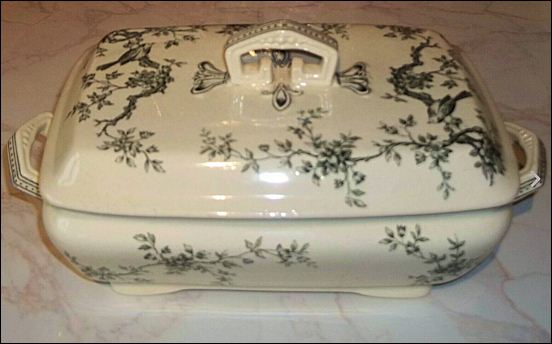 serving tureen in the Alton pattern |
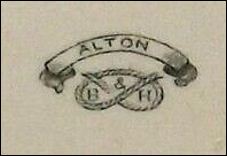 B & H the initials B & H for Bodley & Harrold are contained in a Stafford Knot |
 plate in a blue transfer pattern with hand colouring |
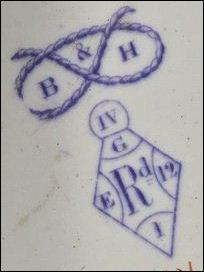 B & H the registration diamond shows that the pattern was registered on the 12th May 1863 to Bodley & Harrold at the Scotia Works, Burslem |
Sandringham pattern
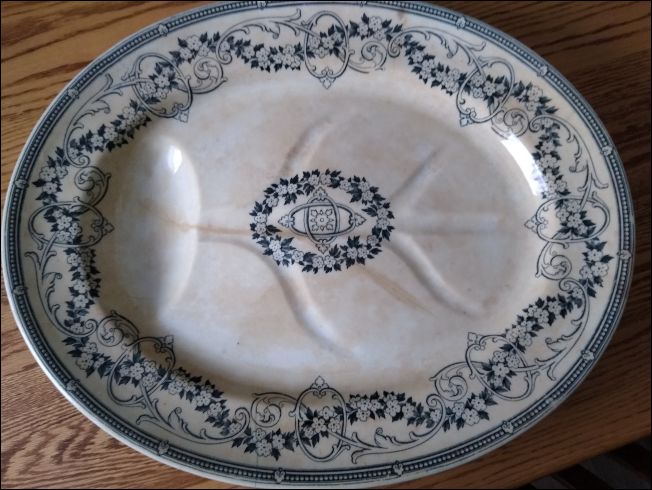 meat platter in the Sandringham pattern the Sandringham pattern was originally
produced by Bodley & Harrold |
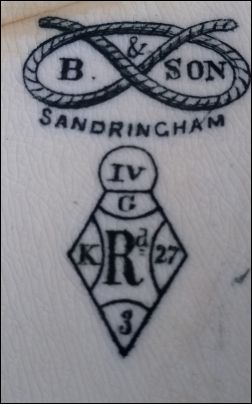 B & Son the registration diamond
shows that the
pattern was registered on the 27th November 1863 to Bodley & Harrold at
the Scotia Works, Burslem. |
photos courtesy: Cynthia Beed
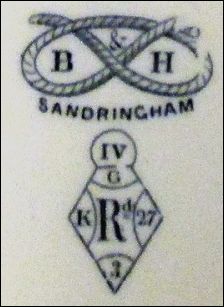 Bodley & Harrold photo source: the original makers of the Sandringham pattern were Bodley & Harrold (c.1863-5) the registration diamond shows that the pattern was registered on the 27th November 1863 |
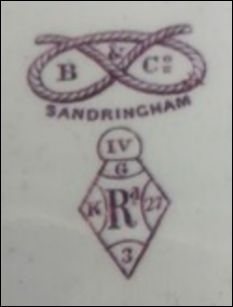 Bodley & Co |
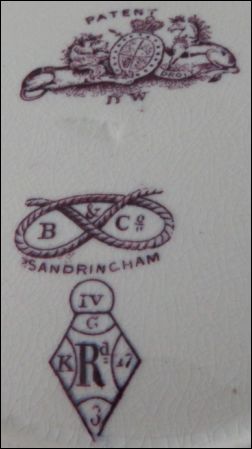 Bodley & Co D W D. W. were likely a Russian importer/retailer based in St. Petersburg. |
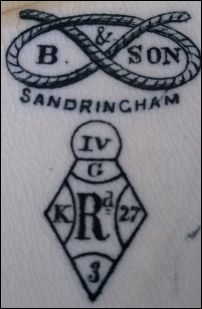 Bodley & Son |
The Bodley father (Edward
Fisher Bodley) and son (Edwin
James Drew Bodley ![]() ) between them operated 3
pottery manufactories.
) between them operated 3
pottery manufactories.
The father operated at all three (Scotia, New Bridge and Hill Top),
the son only operated at New Bridge & Hill Top.They worked the china part of the Hill Top Works concurrently
with the Scotia Works - they moved from the Scotia Works to
the New Bridge Works, but continued the Hill Top Works.
Edward F Bodley & Son
Scotia Pottery, Burslem, Staffordshire
manufacturers of
Genuine Ironstone China,
and the highest class of Earthenware of Every Description
including Printed, Enamelled and Gilt, Dinner, Toilet, Tea and Desert Ware, both in White
and Coloured bodies, Teapots, Jugs, &c., &c
The Pottery Gazette, March 1st 1880
E F Bodley & Son
New Bridge Pottery, Longport, Staffordshire
Manufacturers of
Genuine Ironstone China and Earthenware
Ivory Toilet, Dinner, Tea & Dessert ServicesPottery Gazette, January 1885
Manufacturers of Genuine Ironstone China for
Steamships, Hotel, Coffee House and Mess purposes generally
E F Bodley & Sons
all kinds of Printed and Decorated Earthenware
for Home and Foreign Markets
New Bridge Pottery, Longport, Staffordshire
Pottery Gazette Diary, 1896
Note the company name "& Sons" which is unusual as all directory listings (including the 1896 one) are "& Son"
it is not known if this was a mistake or if a further son was taking into partnership
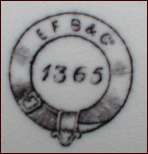
E
F Bodley & Co backstamp

Location and period of operation:
|
Edward F Bodley & Co |
Burslem |
1862 |
|
| Bodley & Co |
Burslem |
1865 | |
| Edward F. Bodley and Son |
Burslem |
1880 | 1881 |
| Edward F. Bodley and Son |
Longport New Bridge Pottery |
1881 |
E F Bodley died in 1881. Works closed 1898 |
| Bodley & Diggory |
Burslem Hill Top Works |
1870 | 1874 |
| Bodley & Son |
Burslem Hill Top Works |
1874 | 1875 |
| E J D Bodley |
Burslem Hill Top Works |
1875 | 1892 |
* in 1882 they renamed the china works of the Hill Top Pottery 'Crown Works'
Initials used on ware for identification:
| Bodley & Co | B & Co |
| Edward F Bodley & Co | E F B & Co
E F B SCOTIA POTTERY BODLEY (could be the mark of the other Bodley firms) |
| Edward F Bodley & Son | E F B & SON
E F B & SON |
| Bodley & Son | B & SON |
| E J D BODLEY | E J D BODLEY
E J D B |
| Bodley & Harrold | B & H
BODLEY & HARROLD SCOTIA POTTERY (printed within a Staffordshire Knot) |
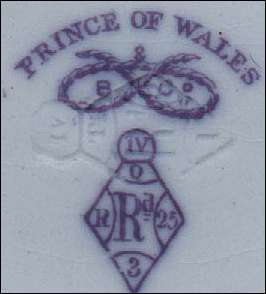
Staffordshire knot mark of Bodley & Co
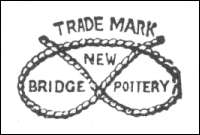
Staffordshire knot mark of New Bridge Pottery
Edward F Bodley & Son
Bodley & Harrold
Click links below for more information:
Scotia
Works - Burslem
New Bridge Works - Longport
Hill Top Works
- Burslem
(later renamed
Crown Works)
The Scotia Pottery "This manufactory was originally the parish workhouse of Burslem, and was calculated to accommodate three hundred inmates. On the establishment of unions, under the Poor-Law Act, when the new union workhouse was erected, this building was occupied as barracks, and so continued for some years. It was then converted into a manufactory by Mr. James Vernon in 1857, and he, in 1862, was succeeded by the present firm of "Edward F. Bodley & Co." At these works the usual descriptions of earthenware, printed, enamelled, and gilt, and " ironstone china," for steamship and hotel use, are made. The bodies and glazes, which have been considerably improved by the manager, Mr. Edward Beardmore, of Rode Heath, are, through his attention and skill, of a very high quality. The mark is the Staffordshire knot, with the words SCOTIA WORKS."
Llewellynn Jewitt The Ceramic Art of Great Britain" 1878
BODLEY, Edward Fisher (1815-81), pottery manufacturer, Burslem.
Edward Fisher Bodley was born in Lapford, Devonshire, in 1815. By the age of 24 he was living in Steeple Bumpstead, Essex, where he was an Independent minister of religion given to revivalist sermons.
He moved to Rochford, Essex, where he married and had three children.
Scotia Pottery:
After the death of his wife he came to Shelton, Stoke-on-Trent, and is listed as an accountant and as a commercial traveller in directories from 1864 to 1876. He also engaged in pottery manufacture, opening the Scotia Pottery in 1862. The building had originally been the Burslem workhouse and been converted by James Vernon into a pottery. The firm traded as Bodley and Harrold, changed to Edward F. Bodley and Co., and in 1880 to Edward F. Bodley and Sons.New (or Bottom) Bridge Pottery:
In 1881 the business moved to New Bridge Pottery, Longport. It ceased in 1898. Bodley had supplied pottery to the Confederate navy in the American Civil War.Hill Top Pottery:
He was in partnership with Diggory in the manufacture of china 1870-4, using the china department of Samuel Alcock's magnificent Hill Top Pottery. He was still using this pottery in 1881, when his two factories employed between them 350 people.Edward Fisher Bodley had married again, in 1852, Mary Ridgway, by whom he had eight children. He was Liberal in politics, and served as mayor of Hanley 1872-3.
On his retirement he removed to Dane Bank House, Congleton, where he died, on 17 April, 1881.
He was buried in Christ Church, Eaton, near Congleton. His son Edwin James Drew Bodley carried on the business until 1892 when he was declared bankrupt.Sources: Census 1871, 1881; Dir. 1864, 1867, 1875/6; Jewitt; VCH viii. Ward.
1881 census:
Dwelling: Lower Heath Dane Bank House
Census Place: Congleton, Cheshire, England
| Name |
Marr | Age | Sex |
Birthplace | Occupation | |
| Edward F. BODLEY | M 65 M | Head | Bristol, Somerset | Earthenware Manufacturer |
| Mary BODLEY | M 60 F | Wife | Hanley | |
| Albert J. R. BODLEY | U 25 M | Son | Hanley | Earthenware Manufacturer |
| Beatrice Mary BODLEY | U 22 F | Daur | Hanley | Earthenware Manufacturer Daughter |
| Edward R. BODLEY | U 20 M | Son | Hanley | Earthenware Manufacturer |
| Eliza HUMPHREY | U 65 F | Servant | Steeple Bumpstead, Essex | Nurse Domestic Servant |
| Matilda GLOVER | U 38 F | Servant | Hanley | Cook Domestic Servant |
| Jane WHITFIELD | U 28 F | Servant | Ellesmere, Shropshire | Housemaid Domestic Servant |
| Mary Anne ASPINALL | U 25 F | Servant | Tunstall | Parlourmaid Domestic Servant |
| Emily CORNES | U 22 F | Servant | Silverdale | Parlourmaid |
Questions, comments, contributions? email: Steve Birks
|
Page created 1 June 2020 Last updated 6 December 2025: 1896 advert for E F Bodley & Sons added. |